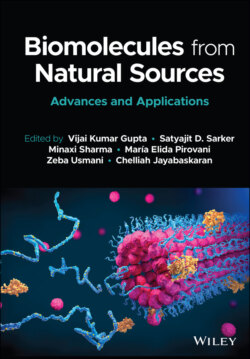Читать книгу Biomolecules from Natural Sources - Группа авторов - Страница 67
2.4.4 Chitin and Chitosan
ОглавлениеChitin was discovered in 1811 by Braconnot and was initially termed fungine because it was discovered in mushrooms [25], it is derived from shrimp, crab, Antarctic krill, and cultivated fungi. It was later in 1823 that Odier gave the name chitin to the same material discovered now in the elytrum of the cock chafer beetle based on the Greek term chitos, meaning coat. Chitin as a natural polysaccharide is a tough, semitransparent horny substance; the principal component of the exoskeletons of arthropods and the cell walls of certain fungi.
Chitosan is known as soluble chitin [162–167]. Chitosan is produced commercially by deacetylation of chitin. It has many uses: diluent, binder, drug carrier, drug release, site specific drug delivery, absorption, enhancer, carrier, anticancer, anticoagulant, antiviral, antioxidant, tissue engineering and food technology. Chitosan is soluble in water and in some organic solvents. The difference between chitin and chitosan is defined by their solubility in a dilute solution of weak acids. Chitosan dissolves in dilute acetic acid. It presents a unique combination of properties, brought about by its polysaccharide structure, large molecular weight, and cationic character. Chitin and chitosan are biocompatible and present antithrombogenic and hemostatic properties. These polymers can be extruded to make films for packaging applications. Chitosan is used in many applications including: hydrogel, tissue engineering, drug delivery, tissue repair.
Chitosan is the partially or fully deacetylated form of chitin. The chitosan deacetylation degree is usually in the range between 70% and 95%, and the molecular weight is also between 10 to 1000 kDa. Its application in the tissue engineering and drug delivery fields is wide ranging from cartilage, bone, vascular grafts and skin to substrates for cell culture. Biologically renewable, biocompatible, biodegradable, non-toxic and non-antigenic properties of chitosan make it a bio-functionally useful biomaterial. In addition, hydroxyl and amino groups of chitosan can be modified chemically to provide a high chemical diversity. It also has bio-adhesive properties. Chitosan exhibits different behaviors at various pH levels. It does not dissolve at high pH while it is soluble at lower pH ranges. This property makes chitosan a suitable tool for delivery applications. Chitosan, and their derivatives have found a number of pharmaceutical or biomedical applications. Although chitosan was mostly used as a diluent in tablet manufacturing, it was also proposed as a binder, lubricant, or potential disintegrating agent. The mucoadhesive properties of chitosan make it an attractive material for the local delivery of drugs in the oral cavity.
